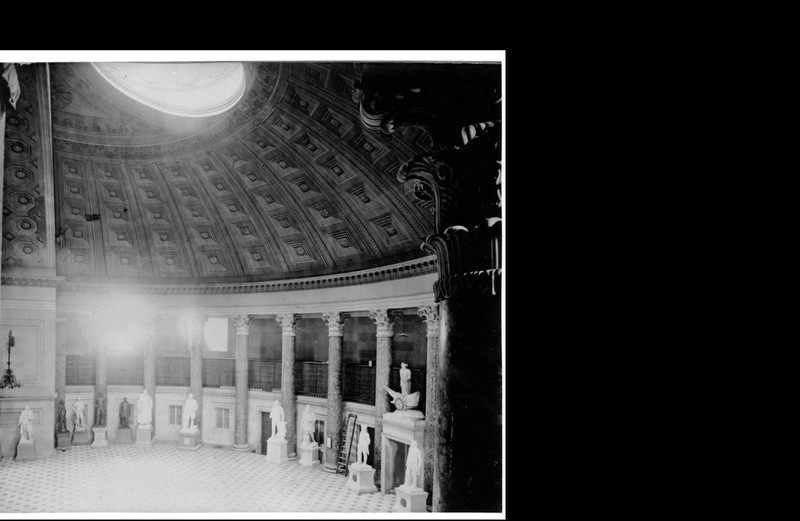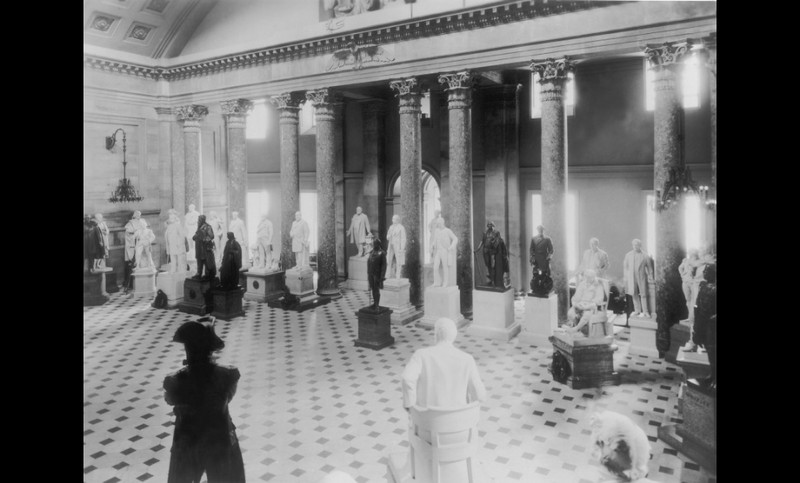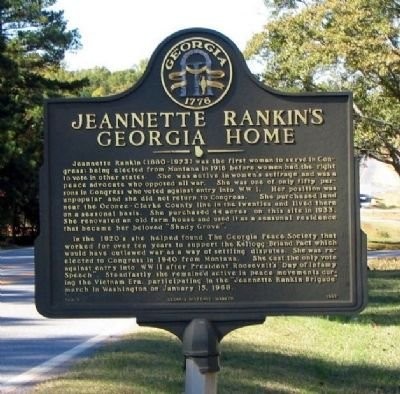Jeannette Rankin's Georgia Home Historical Marker
Introduction
Text-to-speech Audio
Images
The National Statuary Hall in 1890 from the Architect of the Capitol. They had replaced the floor of the hall at Congressmen Justin Morrill's request.

The National Statuary Hall in 1932 from the Prints and Photographs Division of the Library of Congress. Since the hall was crowded at this time, some statues were placed in other locations in the Capitol.

The Jeannette Rankin Statue in the Emancipation Hall in the U.S. Capitol Visitor Center.

This historical marker was dedicated in 1992 and is located on property that was purchased by Jeannette Rankin in 1933.

Backstory and Context
Text-to-speech Audio
In 1933, the former Congresswoman purchased 44 acres at this site which included an older farmhouse where she lived on a seasonal basis. She referred to the home as "Shady Grove" and lived here for several years while presiding over the Georgia Peace Society. In 1940, the people of Montana again supported her candidacy and she returned to Congress where she opposed US involvement in World War II. While she was one of fifty people in Congress to oppose entry in World War I, hers was the only vote in opposition to a declaration of war after Pearl Harbor. Rankin also opposed US involvement in Vietnam as a private citizen. Rankin died in Carmel, California on May 18, 1973.
Deeply controversial in her own time for her opposition to World War II, today Rankin has been enshrined into the National Statuary Hall. The history of the Hall begins in 1857 when the House of Representatives moved into a new chamber leaving an empty space in the capitol. Congressman Justin Morrill from Vermont proposed that the former chamber should become the National Statuary Hall, which would house statues of notable Americans. He proposed states would donate two bronze or marble statues of deceased men or women from their state who deserve a memorial at the capitol. On July 2, 1864, President Abraham Lincoln passed Morrill’s proposal into law.
The National Statuary Hall Collection within the United States Capitol Building consists of 100 statues, two statues donated by each of the 50 states. The 100-statue collection is spread throughout the capital. Thirty-five statues are displayed in the National Statuary Hall, six are displayed in the Rotunda, 13 are displayed in the Crypt, 13 are displayed in the Hall of Columns and 24 are displayed in the Capitol Visitor Center. The other nine statues are in various areas in the House and Senate wings of the Capitol building.
Jeannette Rankin’s statue is in the Capitol Visitor Center along with most of the other statues of women. The decision to replace statues of men with women such as Rankin demonstrates the way historical interpretation change, although visitors to the Capitol are sure to notice that most of the statues of women are in the Capitol Visitors Center rather than the Rotunda or Statuary Hall. Emancipation Hall, where Rankin’s statue is located, was named in recognition of the slaves who built the United States Capitol. The Rankin statue honors her commitment to peace and women's right to vote. While her positions were controversial in her own time, Rankin was selected by leaders of Montana owing to her status as the first woman elected to the U.S. House of Representatives.
Sources
2. A Hall of Heroes. U.S. Capitol Visitor Center. . Accessed August 28, 2018. https://www.visitthecapitol.gov/exhibitions/timeline/image/national-statuary-hall-ca-1890.
3. "National Statuary Hall, ca. 1890." U.S. Capitol Visitor Center. Architect of the Capitol, https://www.visitthecapitol.gov/exhibitions/timeline/image/national-statuary-hall-ca-1890.
4. "National Statuary Hall, 1932." U.S. Capitol Visitor Center. Prints and Photographs Division. Library of Congress, https://www.visitthecapitol.gov/exhibitions/timeline/image/national-statuary-hall-1932.
5. "National Statuary Hall, today." U.S. Capitol Visitor Center. Architect of the Capitol, https://www.visitthecapitol.gov/exhibitions/timeline/image/national-statuary-hall-today.
6. U.S. Capitol Visitor Center. Architect of the Capitol. . Accessed August 28, 2018. https://www.aoc.gov/capitol-buildings/us-capitol-visitor-center.
7. USCapitol Flickr user. "Emancipation Hall in the Capitol Visitor Center." Architect of the Capitol. Flickr.com, October 26, 2011. https://www.aoc.gov/capitol-buildings/us-capitol-visitor-center.
8. Jeannette Rankin. Architect of the Capitol. April 01, 2011. Accessed August 29, 2018. https://www.aoc.gov/sites/default/files/rankin_2011.pdf.
9. USCapitol Flickr User. "Jeannette Rankin Statue." Architect of the Capitol. Flickr.com, October 20, 2011, https://www.aoc.gov/art/national-statuary-hall-collection/jeannette-rankin.
